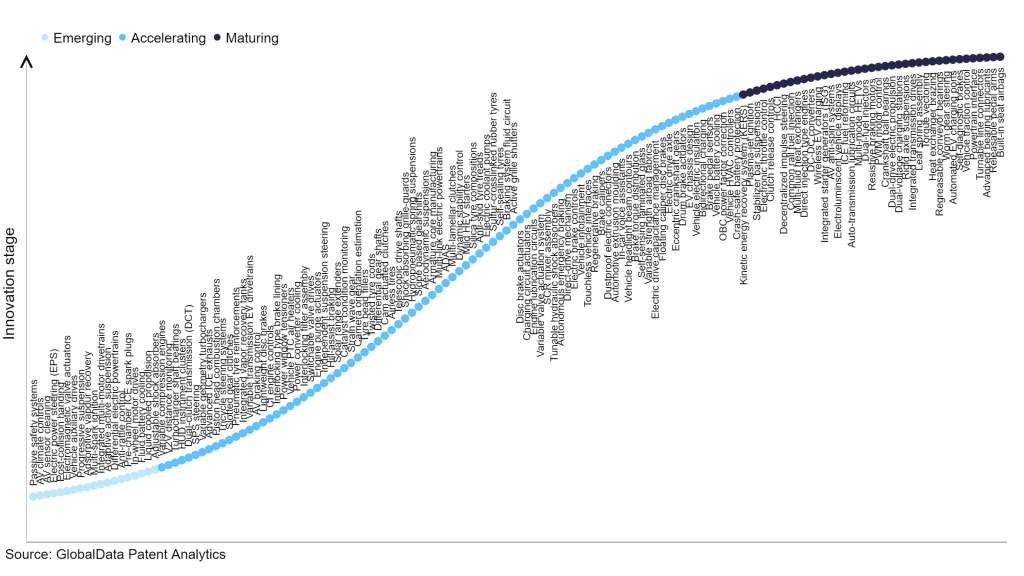The automotive industry continues to be a hotbed of patent innovation. Activity in variable valve actuation system is driven by enhanced fuel economy, emissions control, improved performance, and advancements in materials science, electronics, and sustainable practices. In the last three years alone, there have been over 1.7 million patents filed and granted in the automotive industry, according to GlobalData’s report on Innovation in automotive: variable valve actuation system. Buy the report here.
However, not all innovations are equal and nor do they follow a constant upward trend. Instead, their evolution takes the form of an S-shaped curve that reflects their typical lifecycle from early emergence to accelerating adoption, before finally stabilizing and reaching maturity.
Identifying where a particular innovation is on this journey, especially those that are in the emerging and accelerating stages, is essential for understanding their current level of adoption and the likely future trajectory and impact they will have.
300+ innovations will shape the automotive industry
According to GlobalData’s Technology Foresights, which plots the S-curve for the automotive industry using innovation intensity models built on over one million patents, there are 300+ innovation areas that will shape the future of the industry.
Within the emerging innovation stage, integrated multi-motor drivetrains, electric power steering (EPS), and post-collision handling are disruptive technologies that are in the early stages of application and should be tracked closely. Variable compression engines, V2V distance monitoring, and turbocharger shaft bearings are some of the accelerating innovation areas, where adoption has been steadily increasing. Among maturing innovation areas are kinetic energy recovery system (KERS) and plasma-jet ignition, which are now well established in the industry.
Innovation S-curve for the automotive industry

Variable valve actuation system is a key innovation area in automotive
A variable valve actuation (VVA) system is a mechanism that enables precise control of valve timing, lift, and duration in an internal combustion engine to optimize engine performance. It allows for greater flexibility in combustion chamber design, improving fuel efficiency, reducing emissions, and increasing power output.
GlobalData’s analysis also uncovers the companies at the forefront of each innovation area and assesses the potential reach and impact of their patenting activity across different applications and geographies. According to GlobalData, there are 30+ companies, spanning technology vendors, established automotive companies, and up-and-coming start-ups engaged in the development and application of variable valve actuation system.
Key players in variable valve actuation system – a disruptive innovation in the automotive industry
‘Application diversity’ measures the number of applications identified for each patent. It broadly splits companies into either ‘niche’ or ‘diversified’ innovators.
‘Geographic reach’ refers to the number of countries each patent is registered in. It reflects the breadth of geographic application intended, ranging from ‘global’ to ‘local’.
Patent volumes related to variable valve actuation system
Source: GlobalData Patent Analytics
Eaton is one of the leading patent holders in variable valve actuation (VVA) systems. It filed a patent for a dual-acting hydraulic actuator for improved efficiency and performance in gasoline and diesel engines. The actuator is expected to contribute to improved fuel economy, reduced emissions, and performance. Some other key patent filers in this space include Toyota Motor and Hyundai Motor.
In terms of application diversity, Henkel leads the pack, while Centro Ricerche Fiat and FCA stood in the second and third positions, respectively. By means of geographic reach, Henkel held the top position, followed by Mitsubishi and BRP.
To further understand the key themes and technologies disrupting the automotive industry, access GlobalData’s latest thematic research report on Automotive.
Premium Insights
From

The gold standard of business intelligence.
Blending expert knowledge with cutting-edge technology, GlobalData’s unrivalled proprietary data will enable you to decode what’s happening in your market. You can make better informed decisions and gain a future-proof advantage over your competitors.



